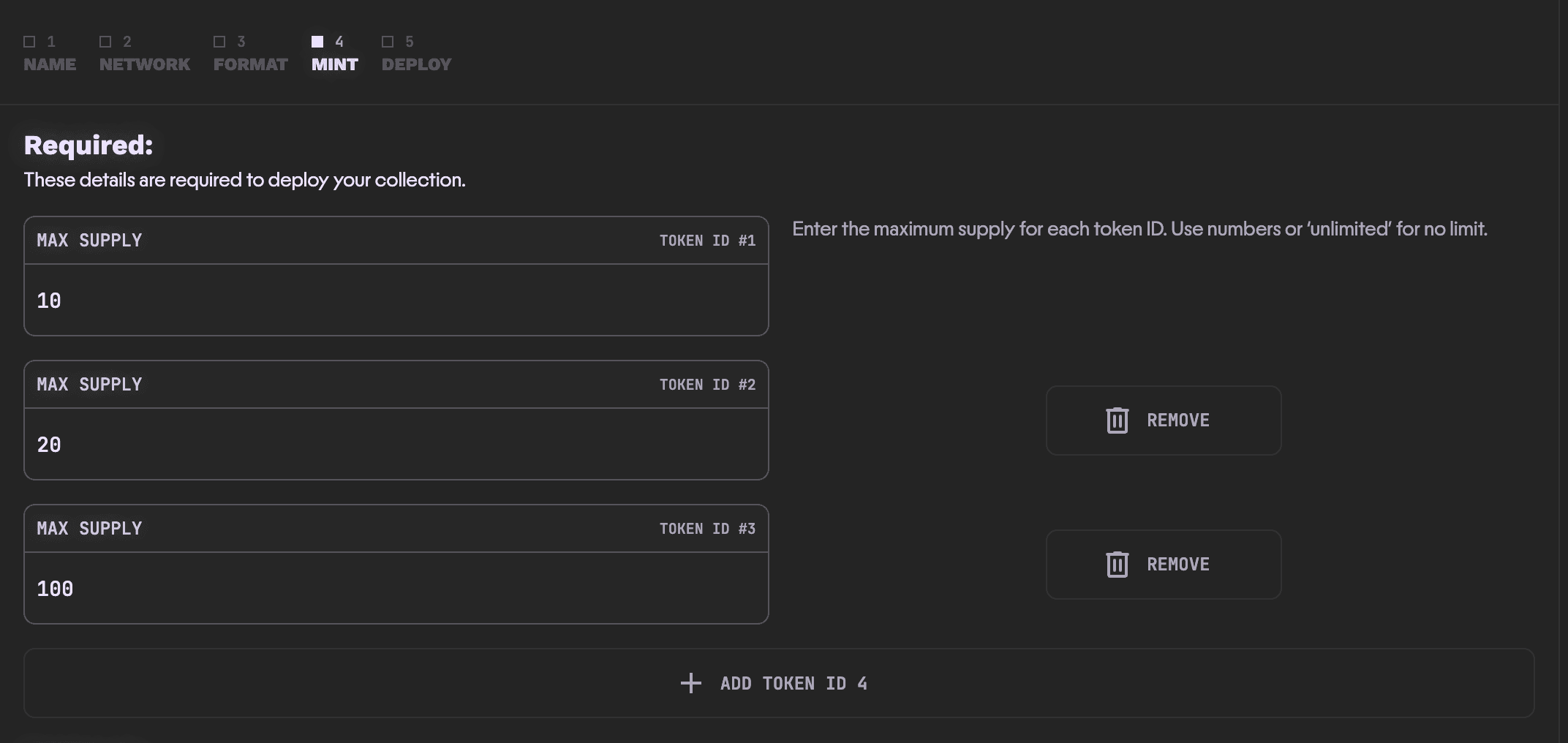ERC-1155
ERC-1155 NFTs are a type of NFT that allows multiple owners to hold copies of the same token. This is different from the more common ERC-721 standard, where each token is unique and can only have one owner. ERC-1155 is perfect for things like open editions, digital trading cards, smaller art drops (where you want to sell multiple copies of the same pieces), or anything else where you plan to mint multiple copies of the same token.
When you launch an ERC-1155 collection on Scatter, you can choose how many copies of each token should be mintable, including making them unlimited. It's also still possible to create tokens with a limit of 1, if you want to have unique pieces within your collection. Users will get to pick which token they mint.
The core differences of a Scatter ERC-1155 compared to our standard ERC-721 contract are:
- Supports multiple mints of individual tokens
- Minters pick which token they want to mint
- You can set different supplies for each token, including making certain ones unlimited
- You set up mint lists (also called invite lists) for each individual token,
which allows you to:
- Make certain tokens exclusively mintable by certain addresses
- Charge separate prices for different tokens
- Set different mint periods and mint limits for different tokens
Open Editions
An open edition sale is a method of selling NFTs that allows for an unlimited number of NFTs to be minted within a given collection. Some open edition sales have time limits, while others remain open indefinitely.
Because ERC-1155 supports unlimited supply tokens, you can set up an open edition sale on Scatter by setting the supply of the desired tokens to unlimited
Networks
Currently Scatter supports ERC-1155 contracts on:
- Ethereum
- Polygon
- Sanko
- Base
- Apechain
- Superposition
Getting Started
To deploy an ERC-1155 NFT collection, ensure you understand the following key requirements and steps for preparing your collection data:
Prepare Your Content and Metadata
-
Create a folder containing your collection's content (images, gifs, etc.) and a separate folder for JSON metadata. See our guide on metadata.
-
Name your content files sequentially as 1.png, 2.png, 3.png, etc., without custom names like image_1.png or image_2.png. Multiple media formats are supported, not just PNG.
-
JSON metadata files must be named 1, 2, 3, etc., without the .json extension (e.g., not 1.json, 2.json).
-
Ensure the index starts at 1, not 0, as Scatter's indexing begins with 1.
-
Once your metadata is ready, you can upload it to IPFS and set the Base URI on your Scatter contract. We have guides on how to do this with Pinata or Filebase and setting the Base URI on your contract. You can also open a ticket with us on Discord ↗ and we can personally guide you through each step.

- IMPORTANT: The metadata/images for tokens displayed here are fetched using the Base URI set on your contract. If your Base URI is not set or your media/metadata is unavailable, the tokens will not be displayed.
Configure Token Supply for ERC-1155
-
Unlike a standard ERC-721 collection, an ERC-1155 NFT collection allows multiple mints of the same token.
-
Define the number of tokens and their maximum supplies during setup. For example, if you configure supplies for three tokens, your collection will include token IDs 1, 2, and 3.
-
Upload metadata for each token (e.g., 1, 2, 3) to ensure they display correctly on the mint page.

Editing Token Supply
-
Using the example below, if we want to add a 4th token with a supply of 400, we would change the set max supply method like this, and make sure to upload the metadata+image for token 4. Similar to ERC721, we cannot lower an individual token's supply lower than the already minted amount.

Additional Information Before Launching
-
We have a variety of useful scripts you can use to do things like clean up your JSON / perform various common tasks here: https://github.com/Scatter-Partners/useful-scripts ↗ Check this link and read which scripts are there so you know if you need these kinds of scripts that they exist for you to use.
-
We have a variety of useful webtools here: https://webtools.scatter.art/ ↗
-
It's recommended to read through most of the documentation before you start so that you can understand all the necessary concepts. Once your images and metadata are ready, you can find an overview for launching the collection in the Deploying and Uploading Guide.
Mint Lists
-
You can create your mint lists as usual, but the difference lies in the Open Edition's ability to create specific mint lists for each token:
-
Under your collection, select the following: 'Edit' then → 'Create Mint List' tab: Here you can enter the name of your mint list and immediately underneath it will give you the option to select a specific Token ID. You then complete the rest as usual. Importantly, this means the mint list created will only be applicable to the selected token ID.